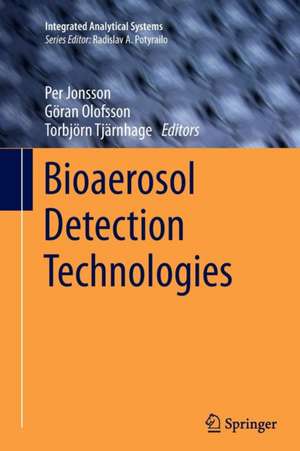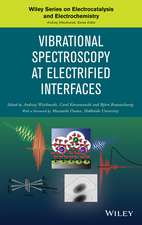Bioaerosol Detection Technologies: Integrated Analytical Systems
Editat de Per Jonsson, Göran Olofsson, Torbjörn Tjärnhageen Limba Engleză Paperback – 3 sep 2016
| Toate formatele și edițiile | Preț | Express |
|---|---|---|
| Paperback (1) | 1001.50 lei 6-8 săpt. | |
| Springer – 3 sep 2016 | 1001.50 lei 6-8 săpt. | |
| Hardback (1) | 1007.65 lei 6-8 săpt. | |
| Springer – 2 aug 2014 | 1007.65 lei 6-8 săpt. |
Din seria Integrated Analytical Systems
- 19%
 Preț: 588.66 lei
Preț: 588.66 lei - 18%
 Preț: 1229.40 lei
Preț: 1229.40 lei - 18%
 Preț: 954.45 lei
Preț: 954.45 lei - 15%
 Preț: 641.71 lei
Preț: 641.71 lei - 15%
 Preț: 638.43 lei
Preț: 638.43 lei - 15%
 Preț: 658.05 lei
Preț: 658.05 lei - 15%
 Preț: 651.99 lei
Preț: 651.99 lei - 18%
 Preț: 959.19 lei
Preț: 959.19 lei - 18%
 Preț: 966.15 lei
Preț: 966.15 lei - 18%
 Preț: 1007.65 lei
Preț: 1007.65 lei - 15%
 Preț: 698.80 lei
Preț: 698.80 lei - 18%
 Preț: 1393.09 lei
Preț: 1393.09 lei - 18%
 Preț: 725.71 lei
Preț: 725.71 lei - 15%
 Preț: 639.25 lei
Preț: 639.25 lei - 18%
 Preț: 1226.11 lei
Preț: 1226.11 lei
Preț: 1001.50 lei
Preț vechi: 1221.34 lei
-18% Nou
Puncte Express: 1502
Preț estimativ în valută:
191.64€ • 208.82$ • 161.48£
191.64€ • 208.82$ • 161.48£
Carte tipărită la comandă
Livrare economică 23 aprilie-07 mai
Preluare comenzi: 021 569.72.76
Specificații
ISBN-13: 9781493939657
ISBN-10: 1493939653
Pagini: 347
Ilustrații: XVII, 330 p. 126 illus., 56 illus. in color.
Dimensiuni: 155 x 235 x 19 mm
Greutate: 0.49 kg
Ediția:Softcover reprint of the original 1st ed. 2014
Editura: Springer
Colecția Springer
Seria Integrated Analytical Systems
Locul publicării:New York, NY, United States
ISBN-10: 1493939653
Pagini: 347
Ilustrații: XVII, 330 p. 126 illus., 56 illus. in color.
Dimensiuni: 155 x 235 x 19 mm
Greutate: 0.49 kg
Ediția:Softcover reprint of the original 1st ed. 2014
Editura: Springer
Colecția Springer
Seria Integrated Analytical Systems
Locul publicării:New York, NY, United States
Cuprins
Introduction and Bioaerosol Detection Terminology.- History of the Early Biodetection Development.- Physical and Biological Properties of Bioaerosols.- Dispersion in the Atmosphere.- Aerosol Sampling and Transport.- Light Scattering and Particle Charge Techniques for the Detection of Biological Warfare Agents.- Bioaerosol Detection with Fluorescence Spectroscopy.- Bioaerosol Detection with Atomic Emission Spectroscopy.- Mass Spectrometry Techniques in the Analysis of Bioaerosols: Development and Advancement.- Detection of Bioaerosol by Raman Spectroscopy.- Biological Detection with Terahertz Spectrocopy.- Introduction to Stand-off Detection of Biological Warfare Agents.- Spectrally Resolved Laser-Induced Fluorescence Lidar Based Standoff Biodetection System.- Standoff Aerosol Size Determination Based on Multiple Field-of-View Elastic Scattering.- Trends in Biological Detection.
Notă biografică
Per Jonsson received his M.Sc. in Electrical Engineering from KTH - Royal Institute of Technology, Stockholm, Sweden in 1996 and his Ph.D. in Photonics from KTH in 2002. Dr. Jonsson joined FOI – Swedish Defence Research Agency in 2002 and is presently a senior scientist within the competence group Laser Systems in the Department of Sensors and EW systems in Linköping. His main research area at FOI has been detection of biological and chemical warfare agents. He has mainly worked with systems based on ultraviolet laser-induced fluorescence, but has also investigated other technologies such as elastic scattering, Raman spectroscopy and laser-induced breakdown spectroscopy. The work includes systems both for point (local) and standoff (distance) detection.
Göran Olofsson, received a M. Sc. & eng. in Physical engineering at the Linköping Institute of Technology in 1976. Mr Olofsson joined the Division for CBRN Defence and Security at the Swedish Defence Research Agency, FOI (then FOA) in 1979, where he since then has been active in the area of CWA and BWA detection, often as project manager and since 2002 holding the position as Research Director. Mr Olofsson was in 1991 an inspector for UNSCOM in Iraq. He also served at the Assistance and Protection Branch of OPCW, for a shorter period in 2002 and was during 2005/06 for 10 months stationed at CEB (now DGA Maîtrise NRBC) in VERT-LE-PETIT, France. Mr Olofsson is presently mainly working with UV-Raman spectroscopy for chemical and biological detection.
Torbjörn Tjärnhage received his B.Sc. in Chemistry from Umeå University, Sweden in 1989 and his Ph.D. in Analytical Chemistry from Umeå University in 1996. Dr Tjärnhage joined FOI – Swedish Defence Research Agency in 1995. Since 2000 his research areas has been focused towards real-time spectroscopic characterization of biological aerosols in combination with multivariate data extraction techniques. Thisalso includes more applied work directed to support to the Swedish Armed Forces development of biodetection capabilities. In 2006 Dr. Tjärnhage was promoted senior scientist and has been project manager for biological detection projects.
Göran Olofsson, received a M. Sc. & eng. in Physical engineering at the Linköping Institute of Technology in 1976. Mr Olofsson joined the Division for CBRN Defence and Security at the Swedish Defence Research Agency, FOI (then FOA) in 1979, where he since then has been active in the area of CWA and BWA detection, often as project manager and since 2002 holding the position as Research Director. Mr Olofsson was in 1991 an inspector for UNSCOM in Iraq. He also served at the Assistance and Protection Branch of OPCW, for a shorter period in 2002 and was during 2005/06 for 10 months stationed at CEB (now DGA Maîtrise NRBC) in VERT-LE-PETIT, France. Mr Olofsson is presently mainly working with UV-Raman spectroscopy for chemical and biological detection.
Torbjörn Tjärnhage received his B.Sc. in Chemistry from Umeå University, Sweden in 1989 and his Ph.D. in Analytical Chemistry from Umeå University in 1996. Dr Tjärnhage joined FOI – Swedish Defence Research Agency in 1995. Since 2000 his research areas has been focused towards real-time spectroscopic characterization of biological aerosols in combination with multivariate data extraction techniques. Thisalso includes more applied work directed to support to the Swedish Armed Forces development of biodetection capabilities. In 2006 Dr. Tjärnhage was promoted senior scientist and has been project manager for biological detection projects.
Textul de pe ultima copertă
This book is intended to give technological background and practical examples, but also to give general insight into the on-going technology development in the area of biodetection. The content is therefore suitable for an array of stakeholders (decision makers, purchasing officers, etc.) and end-users of biodetection equipment within the areas of health, environment, safety and security, and military preparation. The book is divided into three sections. The first section discusses the fundamental physical and biological properties of bioaerosol's. The second section goes into more detail and discusses in-depth the most commonly used detection principles. The third section of the book is devoted to technologies that have been used in standoff applications. The last section of the book gives an overview of trends in bioaerosol detection. The reader of this book will gain knowledge about the different biodetection technologies and thus better judge their capabilities in relation to desired applications.
Caracteristici
Describes not just aerosols, but direct detection of bioaerosols Provides comprehensive overview of the different physical techniques allowing detection and monitoring of bioaerosols Details a wide area of quasi-instantaneous surveillance systems Includes supplementary material: sn.pub/extras









